(?) 1974 Bellanca 8GCBC Scout, c/n 291-74, C-GJXC, British Columbia Provincial Committee, Air Cadet League of Canada; powered by one 180-hp Lycoming O-360-C2E four-cylinder, horizontally-opposed, air-cooled piston engine with fixed-pitch two-blade McCauley propeller; tandem pilot and passenger, STOL (short take-off and landing) glider tow plane; built by Bellanca Aircraft Corporation, Plainview, Texas, USA at Osceola, Wisconsin; first registered to Air Cadet League of Canada on June 16, 1977; sold in 1984; C-GJXC, D. Fritzke, CFB Comox (YQQ), Comox, Vancouver Island, B.C. from 1989 to 1993; C-GJXC, G. Senkowski, Courtenay, Vancouver Island, B.C. from 1993 to 1995.
Schweizer SGS 2-33A, construction number and registration unknown.
Spring 1978.
When not the passenger in the tow plane or in a glider, we air cadets assisted in the ground operations which included positioning the gliders for take-off and retrieving them after landing, signalling between the tow plane and the glider, holding up and running with the right wing tip until the glider picked up sufficient take-off speed, and retrieving tow ropes dropped by the tow plane prior to it landing, from the grass strip between Runway 16/34 and the parallel tarmac, hooking the tow rope to the tow plane and the glider, and lollipop duty, holding up a big round orange day-glo aluminum sign to stop taxiing aircraft until the tow plane or the glider had passed and landed, at the edge of Taxiway Able, Runway 34, or Taxiway Bravo, Runway 16, depending on the wind direction indicated by the orange wind sock situated on the grass strip.
Possible gliders and tow planes used for familiarization flights by the air cadets of 744 Cowichan Squadron, RCAirC (Royal Canadian Air Cadets) on a few weekends in late spring, summer, and autumn, typically from late March to early November, weather-permitting, at Nanaimo Airport (YCD), Cassidy (near Nanaimo), Vancouver Island, B.C., Canada, were:
1966 Schweizer SGU 2-22E (Model 22), c/n 236, CF-ACC, British Columbia Provincial Committee, Air Cadet League of Canada; tandem student and instructor, training sailplane; built by Schweizer Aircraft Corporation, Elmira, New York, USA; imported in 1967; C-FACC, British Columbia Provincial Committee, Air Cadet League of Canada, re-registered, cancelled on June 18, 1982; C-FACC, Stephen Paton, White Rock, B.C. on January 27, 1983, cancelled on February 4, 1998; exported to USA; N371MS, Wells Air Service Inc., Scotia, Nebraska on January 13, 1999; airworthiness issued on May 14, 1999.
1973 Schweizer SGS 2-33A (Model 33), c/n 268, CF-ACT, British Columbia Provincial Committee, Air Cadet League of Canada; tandem student and instructor, training sailplane; built by Schweizer Aircraft Corporation, Elmira, New York, USA; imported in 1973; CF-ACT, British Columbia Provincial Committee, Air Cadet League of Canada circa 1973, cancelled prior to 1982; off Canadian civil register by 1982.
1959 Schweizer SGU 2-22C (Model 22), c/n 79, CF-LYY, British Columbia Provincial Committee, Air Cadet League of Canada; tandem student and instructor, training sailplane; built by Schweizer Aircraft Corporation, Elmira, New York, USA; imported in 1959; CF-LYY, Air Cadet League of Canada in 1976 or earlier; CF-LYY, British Columbia Provincial Committee, Air Cadet League of Canada by 1976, cancelled on March 8, 1985; C-FLYY, Randall Blackwell, Cold Lake, Alberta on January 22, 1987, based at Medley, Alberta.
1975 Schweizer SGS 2-33A (Model 33), c/n 373, C-GCLK, British Columbia Provincial Committee, Air Cadet League of Canada; tandem student and instructor, training sailplane; built by Schweizer Aircraft Corporation, Elmira, New York, USA; imported in 1975; C-GCLK, British Columbia Provincial Committee, Air Cadet League of Canada on May 29, 1975; currently based at CFB Comox (YQQ), Comox, Vancouver Island, B.C.
1975 Schweizer SGS 2-33A (Model 33), c/n 374, C-GCLL, British Columbia Provincial Committee, Air Cadet League of Canada; tandem student and instructor, training sailplane; built by Schweizer Aircraft Corporation, Elmira, New York, USA; imported in 1975; C-GCLL, British Columbia Provincial Committee, Air Cadet League of Canada on May 29, 1975; currently based at CFB Comox (YQQ), Comox, Vancouver Island, B.C.
1976 Schweizer SGS 2-33A (Model 33), c/n 422, C-GCLU, British Columbia Provincial Committee, Air Cadet League of Canada; tandem student and instructor, training sailplane; built by Schweizer Aircraft Corporation, Elmira, New York, USA; imported in 1976; C-GCLU, British Columbia Provincial Committee, Air Cadet League of Canada on April 7, 1976, cancelled on February 27, 1990; deleted from Canadian civil register.
1976 Schweizer SGS 2-33A (Model 33), c/n 437, C-GCLW, British Columbia Provincial Committee, Air Cadet League of Canada; tandem student and instructor, training sailplane; built by Schweizer Aircraft Corporation, Elmira, New York, USA; imported in 1976; C-GCLW, British Columbia Provincial Committee, Air Cadet League of Canada circa 1976, cancelled on May 22, 1986; C-GCLW, Saskatchewan Provincial Committee, Air Cadet League of Canada, Regina, Saskatchewan on March 18, 1987, based at CFB Moose Jaw (YMJ), Moose Jaw, Saskatchewan; C-GCLW, Region Gliding School (Prairie), Saskatchewan Provincial Committee, Air Cadet League of Canada on January 5, 2004, based at Gimli Industrial Park Airport (YGM), Gimli, Manitoba.
1976 Schweizer SGS 2-33A (Model 33), c/n 452, C-GCLY, British Columbia Provincial Committee, Air Cadet League of Canada; tandem student and instructor, training sailplane; built by Schweizer Aircraft Corporation, Elmira, New York, USA; imported in 1976; C-GCLY, British Columbia Provincial Committee, Air Cadet League of Canada circa 1976, cancelled on June 28, 1982; C-GCLY, Nilson Aircraft Ltd. (aircraft broker), Campbell River, Vancouver Island, B.C. cancelled on August 19, 1987; C-GCLY, Heinz Portmann, Campbell River, Vancouver Island, B.C. on July 29, 1987, cancelled on March 9, 1989; C-GCLY, British Columbia Provincial Committee, Air Cadet League of Canada, Vancouver, B.C. on July 7, 1989, based at CFB Comox (YQQ), Comox, Vancouver Island, B.C.
1977 Schweizer SGS 2-33A (Model 33), c/n 482, C-GFMB, British Columbia Provincial Committee, Air Cadet League of Canada; tandem student and instructor, training sailplane; built by Schweizer Aircraft Corporation, Elmira, New York, USA; imported in 1977; C-GFMB, British Columbia Provincial Committee, Air Cadet League of Canada on June 28, 1977; currently based at CFB Comox (YQQ), Comox, Vancouver Island, B.C.
1954 Cessna L-19A-CE Bird Dog (Model 305A), c/n 23472, CF-TGA, British Columbia Provincial Committee, Air Cadet League of Canada; powered by one 213-hp Continental O-470-11 six-cylinder, horizontally-opposed, air-cooled piston engine with fixed-pitch two-blade McCauley propeller; tandem pilot and passenger, tow plane for Schweizer SGU 2-22 and Schweizer SGS 2-33 gliders; high-lift slotted wing flaps; built by Cessna Aircraft Company, Wichita, Kansas at Wallace Plant, Wichita, Kansas (CE); BuNo 53-8051, US Army; taken on strength as 16702/702, RCAF on October 6, 1954, received in natural metal finish; No. 6 Repair Depot, RCAF Station Trenton, Trenton, Ontario for camouflage painting on October 6, 1954; No. 1 AOP (Air Observation Post) Flight, Camp Petawawa, Petawawa, Ontario on November 19, 1954; Central Experimental and Proving Establishment, RCAF Station Namao, Edmonton, Alberta on July 24, 1957 for cold weather trials; Headquarters Practice Flight, RCAF Station Rockcliffe, Ottawa, Ontario on March 21, 1958; back to No. 1 AOP (Air Observation Post) Flight, Camp Petawawa, Petawawa, Ontario on November 14, 1958; free issue to Canadian Army on May 4, 1961; RCAF Station Lincoln Park, Calgary, Alberta for Category B crash repairs on April 5, 1962; Army Aviation Tactical Training School, Rivers Camp, Rivers, Manitoba on January 2, 1963; Bristol Aerospace, Winnipeg, Manitoba for modifications on February 19, 1964; 3rd Regiment, Royal Canadian Horse Artillery, Camp Shilo, Shilo, Manitoba on April 27, 1965; No. 4 Flight Training School, CFB Rivers, Rivers, Manitoba on May 7, 1968; 3 RCHA, Camp Shilo, Shilo, Manitoba on February 20, 1969, and then to 4 RCHA, CFB Petawawa, Petawawa, Ontario on same day; 5e Régiment d’artillerie légére du Canada, CFB Valcartier, Saint-Gabriel-de-Valcartier, Québec on April 25, 1969; last date as 16702/702 on June 11, 1970; became 119702/702, CAF; redesignated as CO-119 Bird Dog; first date on June 11, 1970, new serial number issued; with 5e Régiment d’artillerie légère du Canada, CFB Valcartier, Saint-Gabriel-de-Valcartier, Québec when renumbered; this unit absorbed by No. 430 Tactical Helicopter Squadron, Mobile Command, on April 26, 1971; No. 422 Tactical Helicopter Squadron, CFB Gagetown, Oromocto, N.B. on October 12, 1971; back to No. 430 Squadron on same day(?); Mobile Command, CFB Uplands, Ottawa, Ontario on June 27, 1972; storage at CFB Saskatoon, Saskatoon, Saskatchewan on October 3, 1972; available for disposal there from January 10, 1973; struck off on March 16, 1973; sold through CADC (Crown Assets Disposal Corporation); Royal Canadian Air Cadets on March 16, 1973; CF-TGA, first registered to Air Cadet League of Canada on April 9, 1974; taken on strength along with 16 other L-19s and four Cessna 182s; re-registered as C-FTGA by 1976; these were sublet to the Air Cadet League’s various provincial committees for glider towing and air cadet familiarization flying; 119702/702 based at CFB Comox (YQQ), Comox, Vancouver Island, B.C.
1954 Cessna L-19A-CE Bird Dog (Model 305A), c/n 23473, CF-TGB, British Columbia Provincial Committee, Air Cadet League of Canada; powered by one 213-hp Continental O-470-11 six-cylinder, horizontally-opposed, air-cooled piston engine with fixed-pitch two-blade McCauley propeller; tandem pilot and passenger, tow plane for Schweizer SGU 2-22 and Schweizer SGS 2-33 gliders; high-lift slotted wing flaps; built by Cessna Aircraft Company, Wichita, Kansas at Wallace Plant, Wichita, Kansas (CE); BuNo 53-8052, US Army; taken on strength as 16703/703, RCAF on October 6, 1954, received in natural metal finish; No. 6 Repair Depot, RCAF Station Trenton, Trenton, Ontario for camouflage painting; No. 1 AOP (Air Observation Post) Flight, Camp Petawawa, Petawawa, Ontario on November 19, 1954; Bristol Aerospace, Winnipeg, Manitoba for Category B crash repairs on November 26, 1957; stored reserve at RCAF Station Lincoln Park, Calgary, Alberta on June 3, 1958; Army Aviation Flight, Camp Borden, Borden, Ontario on March 15, 1959 for “continuation of flying training of Army officers”; regular exercises with militia units in southern Ontario; Air Force Headquarters Practice Flight, RCAF Station Rockcliffe, Ottawa, Ontario on June 1, 1961; Army Aviation Tactical Training School, RCAF Rivers, Rivers, Manitoba on August 22, 1961; Training Command, RCAF Station Centralia, Exeter, Ontario on November 2, 1961; back to AATTS on January 8, 1962; RCAF Station Lincoln Park, Calgary, Alberta on June 7, 1962 for modifications; Bristol Aerospace, Winnipeg, Manitoba for modifications on January 9, 1963; back at AATTS by January 10, 1963; 4th Regiment, Royal Canadian Horse Artillery, Camp Petawawa, Petawawa, Ontario on May 3, 1963; back at AATTS by February 19, 1964, following further modifications at Bristol Aerospace; 1 RCHA, Camp Gagetown, Oromocto, N.B. on May 12, 1964 for summer concentration training from June 15 to July 25, 1964; 4 RCHA, Camp Petawawa, Petawawa, Ontario on July 29, 1964; AOP (Air Observation Post) Troop, 3 RCHA, Camp Shilo, Shilo, Manitoba on January 12, 1965; back to 4 RCHA, Camp Petawawa, Petawawa, Ontario on April 27, 1965; last date as 16703/703 on June 11, 1970; became 119703/703, CAF; redesignated as CO-119 Bird Dog; first date on June 11, 1970, new serial number issued; with 2 RCHA, Camp Petawawa, Petawawa, Ontario when renumbered; loaned to No. 422 Tactical Helicopter Squadron, CFB Gagetown, Oromocto, N.B. from April 22 to May 10, 1971 for Combat Arms School training, then back to 2 RCHA; this unit absorbed by No. 427 Tactical Helicopter Squadron on April 26, 1971; storage at CFB Saskatoon, Saskatoon, Saskatchewan on October 3, 1972; available for disposal there from January 10, 1973; struck off on March 16, 1973; sold through CADC (Crown Assets Disposal Corporation); CF-TGB, first registered to British Columbia Provincial Committee, Air Cadet League of Canada on July 9, 1973; taken on strength along with 16 other L-19s and four Cessna 182s; re-registered as C-FTGB by 1976; these were sublet to the Air Cadet League’s various provincial committees for glider towing and air cadet familiarization flying; 119703/703 based at CFB Comox (YQQ), Comox, Vancouver Island, B.C. for Air Cadet summer camps; registration cancelled on July 7, 1989.
1954 Cessna L-19A-CE Bird Dog (Model 305A), c/n 23479, CF-TGF, British Columbia Provincial Committee, Air Cadet League of Canada; powered by one 213-hp Continental O-470-11 six-cylinder, horizontally-opposed, air-cooled piston engine with fixed-pitch two-blade McCauley propeller; tandem pilot and passenger, tow plane for Schweizer SGU 2-22 and Schweizer SGS 2-33 gliders; high-lift slotted wing flaps; built by Cessna Aircraft Company, Wichita, Kansas at Wallace Plant, Wichita, Kansas (CE); BuNo 53-8058, US Army; taken on strength as 16709/709, RCAF on November 15, 1954; delivered to storage at RCAF Station Lincoln Park, Calgary, Alberta; CJATC, Rivers Camp, Rivers, Manitoba on June 8, 1955; operated by Light Aircraft School, Rivers Camp, Rivers, Manitoba by October 1955; Bristol Aerospace, Winnipeg, Manitoba on November 20, 1959; still at CJATC in 1961, by which time unit was renamed Army Aviation Tactical Training School; Training Command, RCAF Station Centralia, Exeter, Ontario on January 8, 1962; back to AATTS on June 4, 1962; Bristol Aerospace, Winnipeg, Manitoba on February 19, 1964; 3rd Regiment, Royal Canadian Horse Artillery, Camp Shilo, Shilo, Manitoba on December 28, 1965 for brief loan, then back to AATTS; Canadian Forces Navigational School, CFB Winnipeg, Winnipeg, Manitoba on February 19, 1968; No. 4 Flying Training School, CFB Rivers, Rivers, Manitoba on June 17, 1968; Bristol Aerospace, Winnipeg, Manitoba on October 4, 1968; back to Canadian Forces Navigational School, CFB Winnipeg, Winnipeg, Manitoba; back to No. 4 Flying Training School, CFB Rivers, Rivers, Manitoba on March 10, 1970, still there when renumbered; last date as 16709/709 on June 11, 1970; became 119709/709, CAF; redesignated as CO-119 Bird Dog; first date on June 11, 1970, new serial number issued; with No. 4 Flying Training School, CFB Rivers, Rivers, Manitoba when renumbered; storage at CFB Saskatoon, Saskatoon, Saskatchewan on June 12, 1970; No. 4 Flying Training School, CFB Portage la Prairie, Portage la Prairie, Manitoba on June 29, 1970, still there when this was absorbed by No. 3 Canadian Forces Flying Training School the next day; back to storage at CFB Saskatoon, Saskatoon, Saskatchewan on December 7, 1970; available for disposal there from January 10, 1973; struck off on March 16, 1973; sold through CADC (Crown Assets Disposal Corporation); CF-TGF, first registered to Air Cadet League of Canada on September 17, 1973; taken on strength along with 16 other L-19s and four Cessna 182s; re-registered as C-FTGF; these were sublet to the Air Cadet League’s various provincial committees for glider towing and air cadet familiarization flying; 119709/709 based at CFB Comox (YQQ), Comox, Vancouver Island, B.C.; visited Nanaimo Airport (YCD), Cassidy, Vancouver Island, B.C. in November 2005, registered C-FTGF but in original 5-digit Canadian Army markings and natural metal finish colour scheme.

Nanaimo Airport (YCD), informally known as Cassidy Airport, showing hangars, runways, and light aircraft, and the surrounding farms. Seen from the front seat of a Schweizer SGS 2-33A glider in spring 1978.
Schweizer SGS 2-33A seconds away from landing parallel to Runway 16. Two Air Cadets on lollipop duty at the edge of Taxiway Bravo, Nanaimo Airport (YCD). In the background is another Schweizer SGS 2-33A glider and the flight book recorders on the grass strip this side of the tarmac parallel to Runway 16/34. Air Cadets in the old blue-grey wool uniform, the 1941–1976 issue, in spring 1978.
[Agfa Agfamatic 100 sensor viewfinder 126 cartridge film camera, 42.1-mm f/11 lens; Agfa Agfacolor Special CNS 126 20 DIN/80 ASA 20-exposure colour negative cartridge film]
© Copyright photographs by Felix Hayo Scharnberg, 1978 / Stephan Alexander Scharnberg, October 2011































